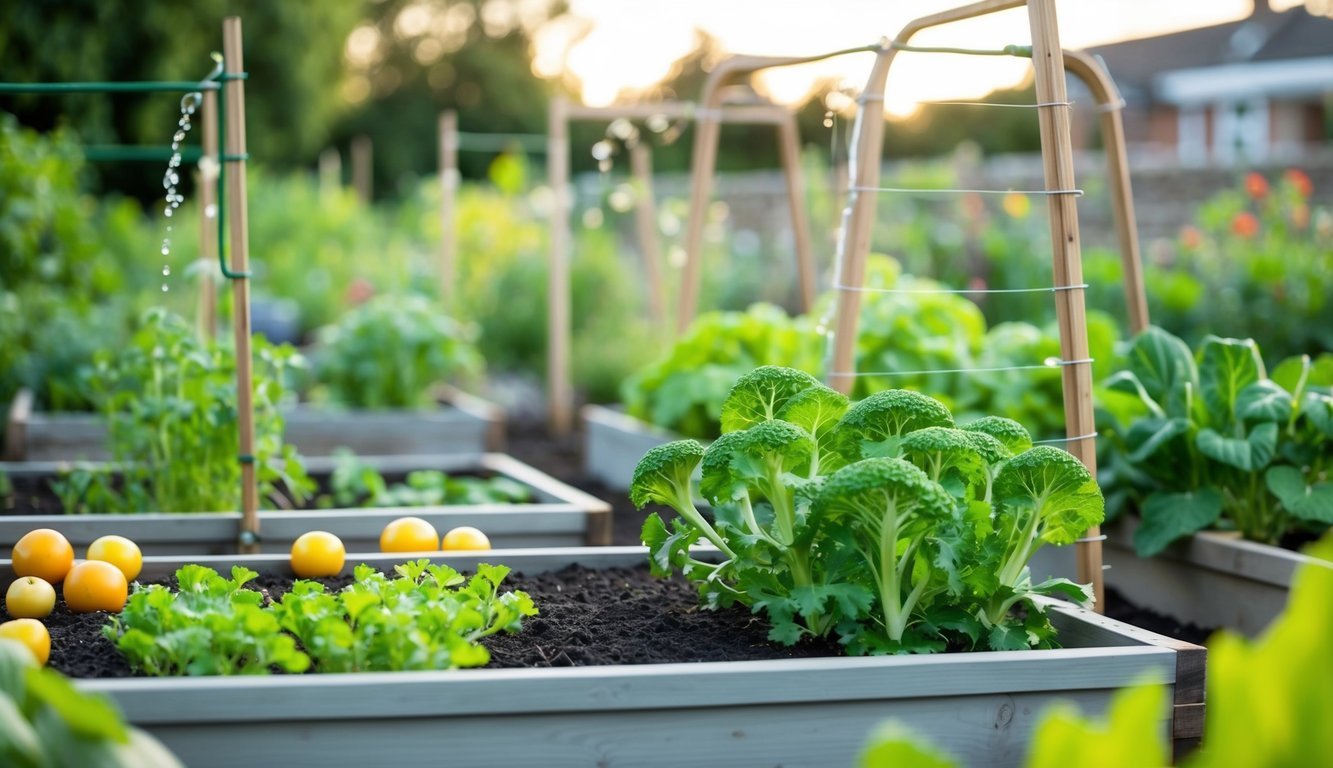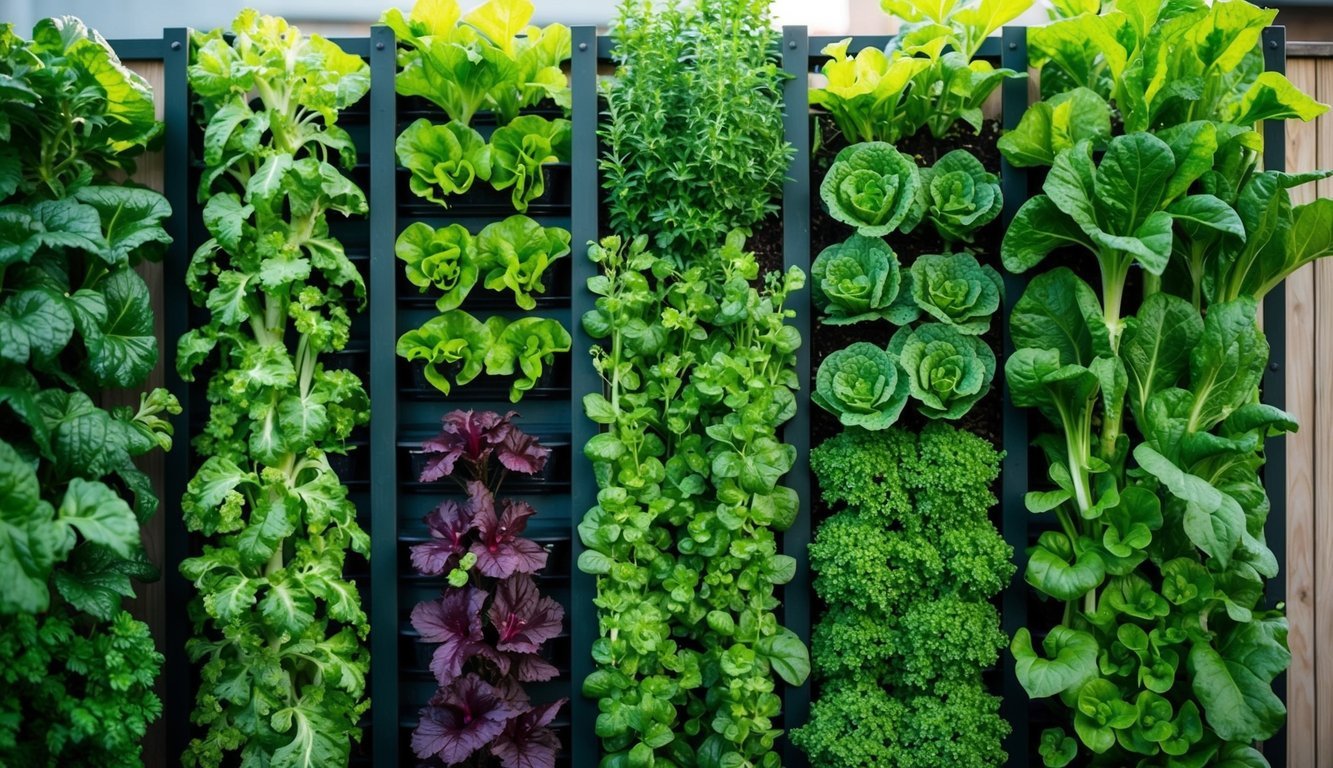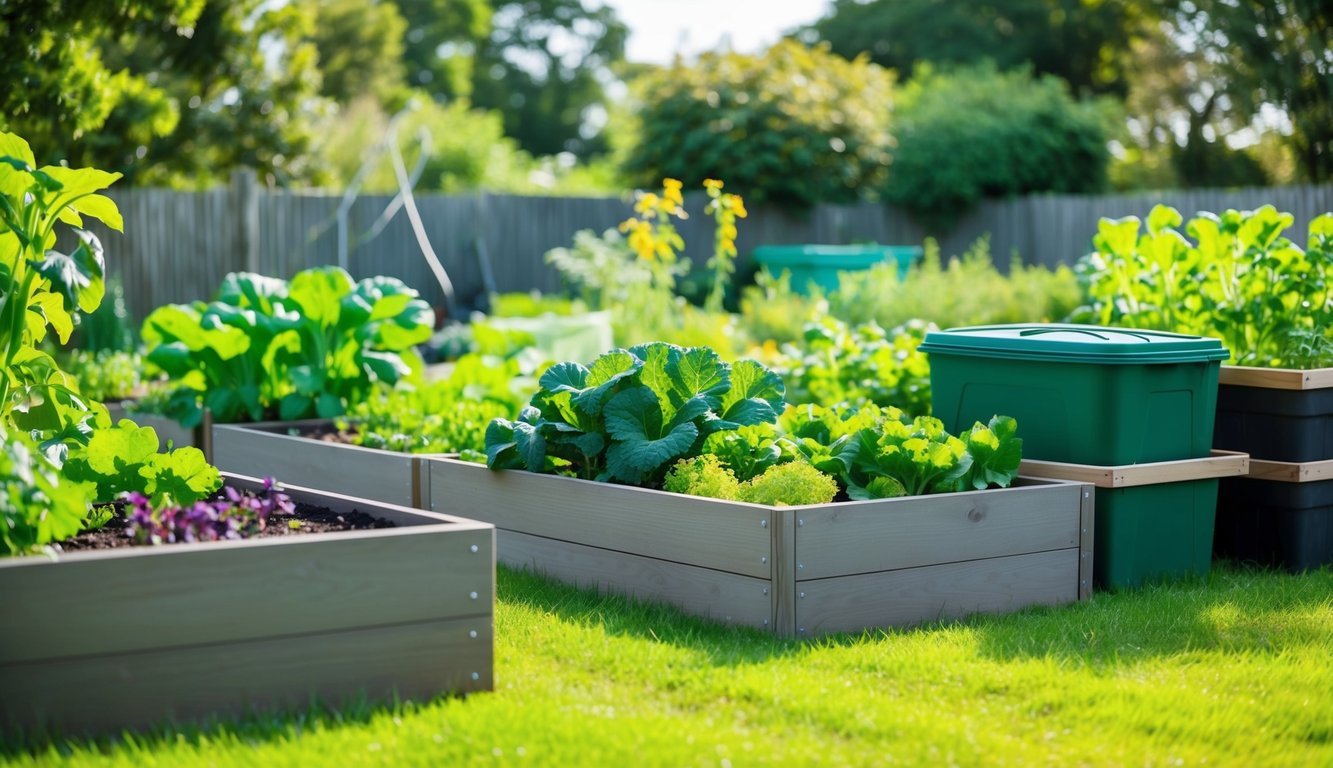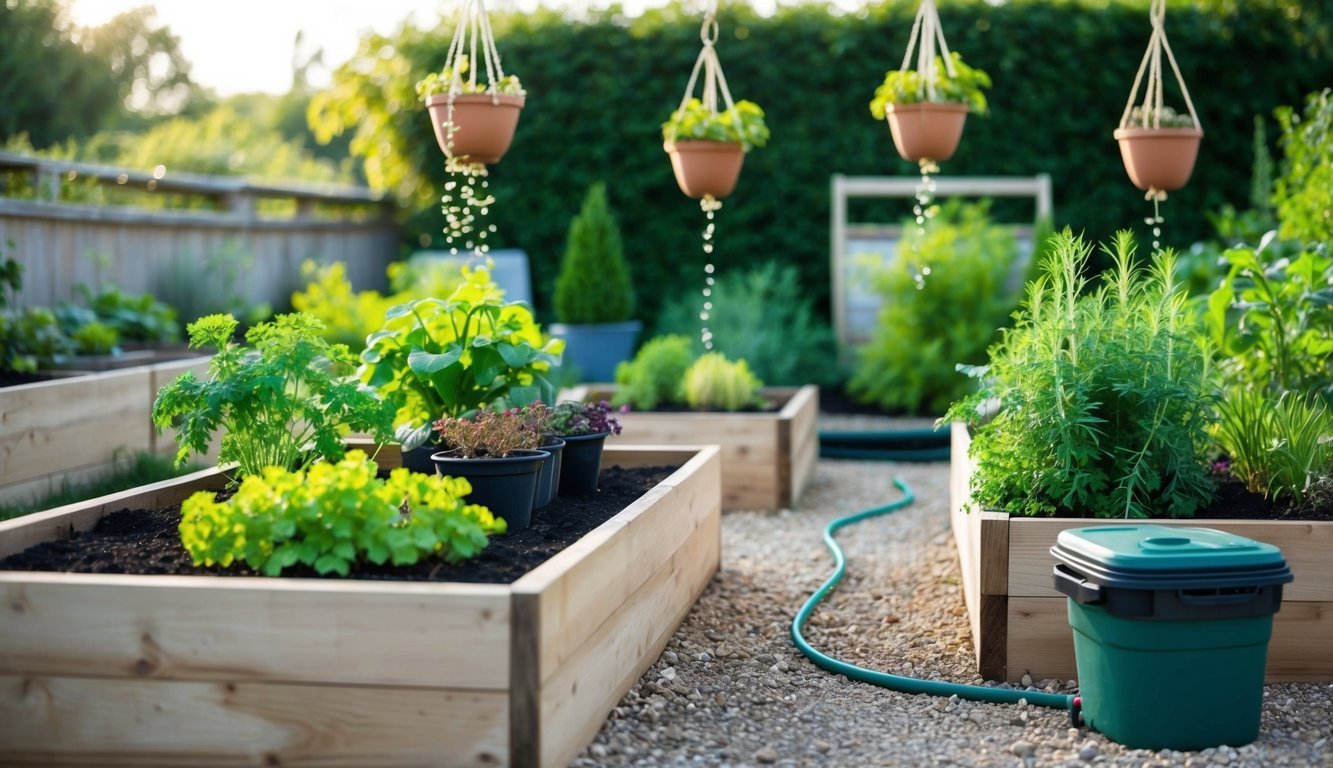Growing your own vegetables can be an enjoyable and rewarding hobby, even for those of us with busy schedules.
You can cultivate a thriving garden without dedicating hours each day.
I’ve discovered some smart strategies that make it easier to get fresh produce without the usual stress that gardening can bring.

With a few simple tips and tricks, I can tend to my garden efficiently and still reap the benefits of homegrown veggies.
Embracing low-maintenance methods allows me to enjoy gardening without it taking over my life, making it a great way to add a bit of nature to my routine.
Square Foot Gardening
Square foot gardening is one of my favorite ways to grow veggies with minimal effort.
It maximizes space and helps me organize my garden better.
I usually start with a 4′ x 4′ raised bed, which gives me sixteen 1′ x 1′ squares.
This layout makes it easy to plan what to plant where.
For instance, I can put in four lettuce plants or just one cauliflower in a square.
Using a special soil mix is key for success.
I opt for “Mel’s Mix,” which is light, fluffy, and weed-free.
It really cuts down on the time I spend weeding later.
When I plant, I consider each plant’s needs.
Grouping plants with similar sun and water needs together really simplifies care.
With this method, I can enjoy a bountiful harvest without the headaches of traditional gardening.
2) Self-Watering Containers
Self-watering containers have become a game changer for me.
They make gardening so much easier, especially when I’m busy or away.
These planters have a built-in reservoir that keeps the soil moist without constant attention.
I’ve tried a few DIY options to create my own self-watering planters.
One of my favorites is using a wine bottle.
It’s simple and effective.
I just poke a hole in the cap, fill the bottle with water, and flip it upside down into the soil.
Another approach involves a wicking system.
I fill a container with potting mix and a wicking basket.
This method draws water up from the reservoir below, ensuring my plants get the moisture they need.
Using self-watering containers means fewer worries about my plants drying out.
It’s perfect for herbs and veggies that thrive on consistent moisture.
Plus, I can enjoy my garden without the stress of daily watering.
It’s like having a little helper for my plants!
Companion Planting
I love using companion planting in my garden.
It’s a simple way to enhance growth and keep pests at bay.
By pairing certain vegetables, I can create a thriving environment with minimal effort.
For example, tomatoes and basil are great partners.
Basil not only boosts tomato flavor but also helps repel pests like aphids and whiteflies.
I’ve noticed healthier plants when I plant them together.
Another beneficial combo is carrots and onions.
The strong scent of onions deters carrot flies, while the roots of carrots don’t compete for nutrients.
This setup makes my garden more efficient.
I also find that planting marigolds among my veggies helps attract beneficial insects.
They draw in pollinators and keep harmful pests under control.
Using a companion planting chart is useful for planning my garden layout.
It shows me which plants work well together and helps maximize my space.
This approach makes gardening easier and more enjoyable for me.
4) Perennial Vegetables
I love the idea of planting vegetables that come back year after year.
Perennial vegetables are a game changer for anyone looking to reduce gardening effort.
One of my favorites is asparagus.
It thrives in deep pots and gives me delicious spears for many seasons.
Plus, it’s packed with nutrients.
Horseradish is another great choice.
This spicy root is easy to grow and tolerates various soil types.
I plant it once, and it keeps producing for up to five years.
Fennel is also a fantastic perennial herb.
Its aromatic bulbs can really elevate a dish.
It prefers full sun and well-drained soil, which makes it pretty low maintenance.
These plants not only minimize my gardening workload but also contribute to a sustainable ecosystem in my garden.
By choosing perennial options, I can enjoy fresh veggies with less effort.
5) Vertical Gardens

I love the idea of vertical gardens for growing veggies with minimal effort.
They’re a smart way to maximize space, especially if I have a small yard or balcony.
Creating a living wall or using a trellis is simple.
I can secure pots filled with herbs, vegetables, or flowers to it.
Not only does it save ground space, but it also adds a unique aesthetic to my area.
I’ve had great success with various plants.
For medium-sized planter boxes, I stick to kohlrabi, garlic, or peas.
For larger boxes, I enjoy growing cucumbers and peppers.
Vertical gardening also makes watering easier.
Since the plants are elevated, I can reach them without bending over too much.
Plus, they often get better sunlight, which can lead to healthier growth.
I appreciate how vertical gardens can encourage me to grow more of my favorite veggies.
They’re fun, practical, and help me feel more connected to my food.
Whether I use wall planters or hanging pots, there’s plenty of room for creativity!
Understanding Permaculture

Permaculture is a sustainable gardening method that focuses on working with nature to create efficient and productive ecosystems.
By understanding its principles and benefits, I can easily cultivate a productive vegetable garden with minimal effort.
Basics of Permaculture
Permaculture combines the concepts of sustainable agriculture, ecology, and landscape design.
The key idea is to create systems that mimic natural ecosystems, resulting in a garden that requires less maintenance.
Several core principles guide permaculture:
- Observe and interact: I assess my environment, taking note of existing plants, animals, and landscape patterns.
- Catch and store energy: I utilize resources like sunlight and rainwater for maximum efficiency.
- Use and value renewable resources: I focus on planting perennial vegetables to reduce the need for yearly replanting.
Understanding these principles allows me to make informed decisions that ultimately simplify the gardening process.
Benefits of Permaculture Gardening
There are numerous perks to adopting permaculture in my veggie garden.
Firstly, it promotes biodiversity, which strengthens the ecosystem, making it more resilient against pests and diseases.
Additionally, permaculture encourages soil health through the use of organic matter and natural composting techniques.
Healthy soil leads to better yields and tastier produce.
Other benefits include:
- Water conservation: By capturing rainwater and creating swales, I’m able to use water more efficiently.
- Less labor: Once established, permaculture gardens require less weeding, watering, and maintenance.
This approach not only makes gardening easier for me but also enhances the health of my garden and the surrounding environment.
Easy-to-Maintain Vegetable Choices

When I think about starting a veggie garden, I always look for plants that require minimal effort yet yield great results.
Choosing the right crops and seeds can make all the difference in how easy my gardening experience is.
Low-Maintenance Crops
Some vegetables are naturally low-maintenance, making them perfect for beginner gardeners like me.
Here are a few fantastic options:
-
Zucchini: This vegetable grows quickly, often producing abundant harvests. It thrives in full sun and is resistant to many common pests.
-
Carrots: Plant them in spring or fall, and they’ll take care of themselves. Just ensure they’re watered and avoid extreme summer heat.
-
Radishes: Fast-growing and straightforward, radishes can be harvested in as little as three weeks, making them extremely rewarding.
-
Lettuce: It grows quickly and can be continually harvested. I can simply cut the leaves and let the plant regrow.
These plants don’t require a lot of attention and can offer bountiful results with minimal work.
Selecting Seeds for Beginners
Choosing the right seeds is crucial for a hassle-free gardening experience.
I recommend looking for seeds labeled as “easy to grow” or “beginner-friendly.”
Here are some tips for seed selection:
-
Look for disease resistance: Some seed packets indicate that the variety is resistant to common issues, which saves you time and effort.
-
Opt for hybrids: Hybrid seeds often produce more uniform crops and may offer better yields.
-
Consider local varieties: Seeds bred for local climates tend to do better with less intervention.
-
Check for sprouting time: I aim for seeds with shorter sprouting times to see faster results.

